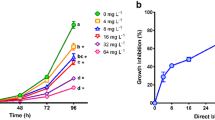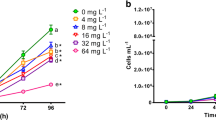Abstract
Nearly 7 00000 tons of dyes are produced annually throughout the world. Azo dyes are widely used in the textile and paper industries due to their low cost and ease of application. Their extensive use results in large volumes of wastewater being discharged into aquatic ecosystems. Large volume discharges constitute a health risk since many of these dyes, such as Congo Red, are elaborated with benzidine, a known carcinogenic compound. Information regarding dye toxicity in aquatic ecosystems is limited. Therefore, the aim of the present study was to evaluate the effect of Congo Red on survival and reproduction of Ceriodaphnia dubia. We determined the 48 h median lethal concentration (LC50) and evaluated the effects of sublethal concentrations in subchronic exposures by using as food either fresh algae or algae previously exposed to the dye. LC50 was 13.58 mg L−1. In subchronic assays, survival was reduced to 80 and 55 %, and fertility to 40 and 70 %, as compared to the control, in C. dubia fed with intoxicated cells or with the mix of intoxicated + fresh algae, respectively, so the quantity and type of food had a significant effect. We determined that Congo Red is highly toxic to C. dubia since it inhibits survival and fertility in concentrations exceeding 3 mg L−1. Our results show that this dye produces negative effects at very low concentrations. Furthermore, our findings warn of the risk associated with discharging dyes into aquatic environments. Lastly, the results emphasize the need to regulate the discharge of effluents containing azo dyes.






Similar content being viewed by others
References
Ali H (2010) Biodegradation of synthetic dyes—a review. Water Air Soil Pollut 213:251–273. doi:10.1007/s11270-010-0382-4
Antunes SC, Castro BB, Goncalves F (2004) Effect of food level on the acute and chronic responses of daphnids to lindane. Environ Pollut 127:367–375. doi:10.1016/j.envpol.2003.08.015
Bae JS, Freeman HS (2007) Aquatic toxicity evaluation of new direct dyes to the Daphnia magna. Dyes Pigments 73:81–85. doi:10.1016/j.dyepig.2005.10.015
Bafana A, Jain M, Agrawal G, Chakrabarti T (2009) Bacterial reduction in genotoxicity of Direct Red 28 dye. Chemosphere 74:1404–1406. doi:10.1016/j.chemosphere.2008.11.043
Bafana A, Krishnamurthi K, Devi S, Chakrabarti T (2008) Biological decolourization of C. I. Direct Black 38 by E. gallinarum. J Hazard Mater 157(1):187–193. doi:10.1016/j.jhazmat.2007.12.085
Bhaskar S, Kuldeep B, Faizal B (2015) Developments in Applied Phycology 7: Algae and environmental sustainability. Springer, New Delhi, India, p 194. doi:10.1007/978-81-322-2641-3, ISBN 978-81-322-2639-0
Blaise C, Férard JF (2005) Small-scale freshwater toxicity investigations. Vol. 1–Toxicity test methods. Springer, Berlin, Germany, p 422. ISBN 978-1-4020-3120-5
Brander SM, Mosser CM, Geist J, Hladik ML, Werner I (2012) Esfenvalerate toxicity to the cladoceran Ceriodaphnia dubia in the presence of green algae, Pseudokirchneriella subcapitata. Ecotoxicology 21:2409–2418. doi:10.1007/s10646-012-0996
Cheriaa J, Bettaieb F, Denden I, Bakhrouf A (2009) Characterization of new algae isolated from textile wastewater plant. J Food Agric Environ 7:700–704
Chia MA, Musa RI (2014) Effect of indigo dye effluent on the growth, biomass, production and phenotypic plasticity of Scenedesmus quadricauda (Chlorococcales). An Acad Bras Cienc 86(1):419–428. doi:10.1590/0001-3765201420130225
de Luna LA, da Silva TH, Nogueira RF, Kummrow F, Umbuzeiro GA (2014) Aquatic toxicity of dyes before and after photo-Fenton treatment. J Hazard Mater 276:332–338. doi:10.1016/j.jhazmat.2014.05.047
Ferraz ERA, Umbuzeiro GA, de-Alameida G, Caloto-Oliveira A, Chequer FMD, Zanoni MVB, Dorta DJ, Oliveira DP (2010) Differential toxicity of Disperse Red 1 and Disperse Red 13 in the Ames Test, HepG2 Cytotoxicity Assay, and Daphnia Acute Toxicity Test. Environ Toxicol 26(5):489–497. doi:10.1002/tox.20576
Fliedner A (1997) Ecotoxicity of poorly water-soluble substances. Chemosphere 35:295–305. doi:10.1016/S0045-6535(97)00156-2
Golka K, Kopps S, Myslak WZ (2004) Carcinogenicity of azo colorants: influence of solubility and bioavailability. Toxicol Lett 15:203–210. doi:10.1016/j.toxlet.2003.11.016
Gómez N, Sierra MV, Cortelizzi A, Capítulo AR (2008) Effects of discharges from textile industry on the biotic integrity of benthic assemblages. Ecotox Environ Safe 69:472–479. doi:10.1016/j.ecoenv.2007.03.007
Hauri JF, Horne HJ (2004) Reduction in labile copper in the 7-day Ceriodaphnia dubia toxicity test due to the interaction with zooplankton food. Chemosphere 56(7):717–723. doi:10.1016/j.chemosphere.2004.04.014
Hernández-Zamora M, Cristiani-Urbina E, Martínez-Jerónimo F, Perales-Vela HV, Ponce-Noyola T, Montes-Horcasitas M, Cañizares-Villanueva RO (2015) Bioremoval of the azo dye Congo Red by the microalga Chlorella vulgaris. Environ Sci Pollut Res Int. 14(22):10811–10823. doi:10.1007/s11356-015-4277-1
Hernández-Zamora M, Perales-Vela HV, Flores-Ortiz CM, Cañizares-Villanueva RO (2014) Physiological and biochemical responses of Chlorella vulgaris to Congo Red. Ecotox Environ Saf 108:72–77. doi:10.1016/j.ecoenv.2014.05.030
Kilham SS, Kreeger DA, Goulden CE, Lynn SG (1997) Effects of algal food quality on fecundity and population growth rates of Daphnia. Freshwater Biol 38:639–647. doi:10.1046/j.1365-2427.1997.00232.x
Kluttgen B, Kuntz N, Ratte HT (1996) Combined effects of 3,4-dichloroaniline and food concentration on life-table data of two related cladocerans, Daphnia magna and Ceriodaphnia quadrangula. Chemosphere 32:2015–2028. doi:10.1016/0045-6535(96)00081-1
Kooijman SAL, Metz JAJ (1984) On the dynamics of chemically stressed populations: The deduction of population consequences from effects on individuals. Ecotox Environ Saf 8:254–274
Martínez-Jerónimo F, Espinosa-Chávez F, Villaseñor-Córdova R (2000) Effect of culture volume and adult density on the neonate production of Daphnia magna, as test organisms for aquatic toxicity test. Environ Toxicol 15:155–159. doi:10.1002/1522-7278(2000)
Novotný C, Dias N, Kapanen A, Malachová K, Vándrovcová M, Itävaara M, Lima N (2006) Comparative use of bacterial, algal and protozoan tests to study toxicity of azo and anthraquinone dyes. Chemosphere 63:1436–1442. doi:10.1016/j.chemosphere.2005.10.002
Øllgaard H, Frost L, Galster J, Hansen O.C (1998) Survey of azo-colorants in Denmark: consumption, use, health and environmental aspects. Ministry of Environment and Energy, Denmark and Danish Environmental Protection Agency, No XX, Copenhagen, pp. 147–290
Purkait MK, Maiti A, DasGupta S, De S (2007) Removal of congo red using activated carbon and its regeneration. J Hazard Mater 145(1-2):287–295. doi:10.1016/j.jhazmat.2006.11.021
Pielz A (1999) The process of the reduction of azo dyes used in dyeing textiles on the basis of infrared spectroscopy analysis. J Mol Struct 511–512:337–344. doi:10.1016/S0022-2860(99)00176-3
Robinson T, McMullan G, Marchant R, Nigam P (2001) Remediation of dyes in textile effluent: a critical review on current treatment technologies with a proposed alternative. Bioresour Technol 77(3):247–255. doi:10.1016/S0960-8524(00)00080-8
Rodgher S, Gaeta Espíndola LE (2008) Effects of interactions between algal densities and cadmium concentrations on Ceriodaphnia dubia fecundity and survival. Ecotox Environ Saf 71(3):106–114. doi:10.1016/j.ecoenv.2007.08.012
Rose RM, Warne MSTJ, Lim RP (2002) Food concentration affects the life history respond of Ceriodaphnia cf. dubia to chemicals with different mechanisms of action. Ecotox Environ Saf 51:106–114. doi:10.1006/eesa.2001.2137
Saratale RG, Saratale GD, Chang JS, Govindwar SP (2011) Bacterial decolorization and degradation of azo dyes: a review. J Taiwan Inst Chem Eng 42:138–157. doi:10.1016/j.jtice.2010.06.006
Savin II, Butnaru R (2008) Wastewater characteristics in textile finishing mills. Environ Eng Manage J 7:859–864
Sharma KP, Sharma S, Sharma S, Singh PK, Kumar S, Grover R, Sharma PK (2007) A comparative study on characterization of textile wastewaters (untreated and treated) toxicity by chemical and biological test. Chemosphere 69:48–54. doi:10.1016/j.chemosphere.2007.04.086
Shore J (1996) Advances in direct dyes. Indian J Fibre Text 21:1–29
Sofyan A, Price DJ, Birge WJ (2007) Effects of aqueous, dietary and combined exposures of cadmium to Ceriodaphnia dubia. Sci Total Environ 385:108–116. doi:10.1016/j.scitotenv.2006.07.003
Sponza DT, Isik M (2005) Toxicity and intermediates of C.I. Direct Red 28 dye through sequential anaerobic/aerobic treatment. Process Biochem 40:2735–2744. doi:10.1016/j.procbio.2004.12.016
U.S. Environmental Protection Agency (2002a) Short-term methods for estimating the chronic toxicity of effluents and receiving waters to freshwater organisms. 4th edn, Office of Research and Development, Cincinnati, OH, EPA-821-R-02-013
U.S. Environmental Protection Agency (2002b) Methods for measuring the acute toxicity of effluents and receiving waters to freshwater and marine organism. EPA-821-R-02-012. 5th edn, Office of Research and Development, Cincinnati, OH
Versteeg DJ, Stalmans M, Dyer SD, Janssen C (1997) Ceriodaphnia and Daphnia: A comparison of their sensitivity to xenobiotics and utility as a test species. Chemosphere 34:869–892. doi:10.1016/S0045-6535(97)00014-3
Wong K, Liu XJ, Lee AOK, Wong PK (2006) Effect of azo dyes on survivorship, oxygen consumption rate, and filtration rate of the freshwater cladoceran Moina macrocopa. Hum Ecol Risk Assess 12:89–300. doi:10.1080/10807030500531604
Yu TH, Dafre AL, de Aragao Umbuzeiro G, Franciscon E (2015) CYP-dependent induction of glutathione S-transferase in Daphnia similis exposed to a disperse azo dye. Ecotoxicology 24(1):232–237. doi:10.1007/s10646-014-1348-x
Acknowledgments
Miriam Hernández-Zamora received a graduate studies scholarship (204491) granted by the Consejo Nacional de Ciencia y Tecnología, and thanks to the Centro de Investigación y de Estudios Avanzados del Instituto Politécnico Nacional for the financial aid rendered and the Escuela Nacional de Ciencias Biológicas for providing the necessary facilities to conduct the present study. Fernando Martínez-Jerónimo acknowledges the Secretaria de Investigación y Posgrado I. P. N., and the Comisión de Operación y Fomento de Actividades Académicas del I. P. N. for the support provided. All the authors are also thankful to Mrs. Ingrid Mascher for copyediting this manuscript.
Author information
Authors and Affiliations
Corresponding author
Ethics declarations
Conflict of interest
The authors declare that they have no competing interests regarding the funding sources and findings of this research.
Ethical approval
All applicable international, national, and/or institutional guidelines for the care and use of animals were followed according to the Ethics Committee of the Escuela Nacional de Ciencias Biológicas, I. P. N.
Rights and permissions
About this article
Cite this article
Hernández-Zamora, M., Martínez-Jerónimo, F., Cristiani-Urbina, E. et al. Congo red dye affects survival and reproduction in the cladoceran Ceriodaphnia dubia. Effects of direct and dietary exposure. Ecotoxicology 25, 1832–1840 (2016). https://doi.org/10.1007/s10646-016-1731-x
Accepted:
Published:
Issue Date:
DOI: https://doi.org/10.1007/s10646-016-1731-x




